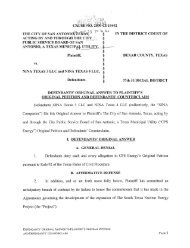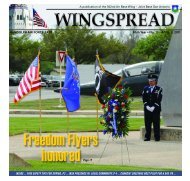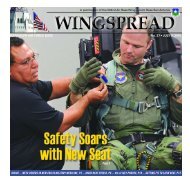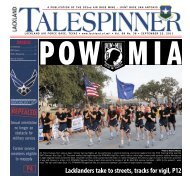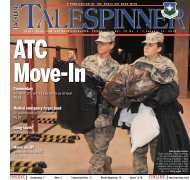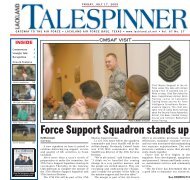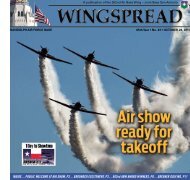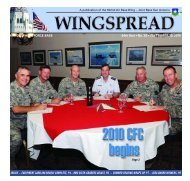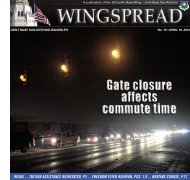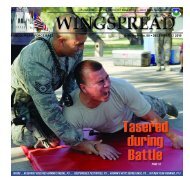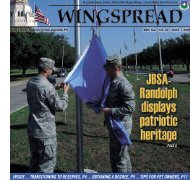JBSA- Randolph Chapel - San Antonio News
JBSA- Randolph Chapel - San Antonio News
JBSA- Randolph Chapel - San Antonio News
Create successful ePaper yourself
Turn your PDF publications into a flip-book with our unique Google optimized e-Paper software.
MARCH 16, 2012 WINGSPREAD<br />
PAGE 7<br />
<strong>JBSA</strong>-<strong>Randolph</strong> advances 'green' initiative with new vehicles<br />
By Alex Salinas<br />
Joint Base <strong>San</strong> <strong>Antonio</strong>-<strong>Randolph</strong> Public Affairs<br />
Joint Base <strong>San</strong> <strong>Antonio</strong>-<strong>Randolph</strong> is<br />
answering the call to consume less energy<br />
with the addition of new fuel-efficient<br />
vehicles to the base motor pool.<br />
Dennis Bazzel, 902nd Logistics<br />
Readiness Squadron vehicle maintenance<br />
manager, said <strong>JBSA</strong>-<strong>Randolph</strong><br />
received three new Ford Fusion hybrids,<br />
purchased by the Air Force, and<br />
that 20 more are expected to arrive on<br />
base by late summer.<br />
“This is an Air Force-wide effort to<br />
push for using alternative fuel,” Bazzel<br />
said. “Hybrids use less fuel and will<br />
be environmentally friendly, especially<br />
on a low-speed driving base like <strong>Randolph</strong><br />
because the cars will use more<br />
battery power. All of the Air Education<br />
and Training Command bases will be<br />
receiving Ford Fusion hybrids.”<br />
In addition to fuel efficiency, the new<br />
vehicles will have lower carbon dioxide<br />
emissions, which will enhance the Air<br />
Force's commitment to 'green' initiatives.<br />
Carbon dioxide pollution is still<br />
rampant in the United States with an<br />
annual carbon output of 20 tons per<br />
person. That’s 16 tons more than the<br />
world average, according to the United<br />
Nations Environment program.<br />
Another major pollutant tracked by<br />
the Environmental Protection Agency<br />
is ground-level ozone.<br />
There is a direct relationship between<br />
temperature and concentrations<br />
of ground-level ozone. As temperatures<br />
increase, primarily from<br />
the amount of carbon dioxide vehicles<br />
emit, ground-level ozone increases,<br />
creating smog.<br />
Kerry Williston, 902nd Civil Engineer<br />
Squadron air quality program<br />
manager, said this can greatly damage<br />
our overall health.<br />
The reduction of air pollution should<br />
be everyone’s concern, Williston said.<br />
“We (<strong>San</strong> <strong>Antonio</strong>) are close to reaching<br />
a nonattainment level during ozone<br />
season, which means the city is at risk<br />
to breathe in sub-par levels of air quality<br />
from May to December,” she said.<br />
These months are especially pertinent<br />
to Texas because of perpetually dry climates<br />
and high temperatures that create<br />
the perfect storm for air pollutants to<br />
stagnate into the atmosphere.<br />
In fact, the northwest region of <strong>San</strong><br />
<strong>Antonio</strong> registered nine days during<br />
summer 2011 on the Texas Commission<br />
on Environmental Quality’s monitor<br />
where the city exceeded the eight-hour<br />
ozone average. These days occurred<br />
from May to October. The air quality<br />
during those days was unhealthy for<br />
sensitive groups, such as children and<br />
people with heart and lung disease.<br />
“Younger children with developing<br />
lungs and elderly people with depressed<br />
immune systems are also the<br />
most affected by poor air quality,” Williston<br />
said. “With poor air quality, they<br />
have to limit their time outdoors.”<br />
Because of summnertime outdoor<br />
activities and vacation travel, Williston<br />
placed a heavy emphasis on drivers to<br />
improve their fuel efficiency, reduce<br />
their carbon dioxide emissions and<br />
improve air quality.<br />
According to the U.S. Department of<br />
Transportation, the average American<br />
drives 13,476 miles per year. There<br />
are a variety of ways to help slash<br />
that average.<br />
“It’s not so much what type of vehicle<br />
you drive, even though that is important<br />
regarding your fuel efficiency, but it’s how<br />
you drive your vehicle,” Williston said.<br />
“Combine as many errands as possible<br />
into one trip. Several short trips taken<br />
from a cold start can use twice as much<br />
fuel as longer, multipurpose trips.<br />
“Taking advantage of carpools, rideshare<br />
programs and public transportation<br />
can cut your weekly fuel costs in half<br />
and save wear on your car if you take<br />
turns driving with other commuters.”<br />
Also, avoiding long idles when your<br />
engine is on and avoiding high speeds<br />
should be on every driver’s mind. Depending<br />
on your vehicle, taking these<br />
measures can save up to 3 cents and<br />
24-80 cents per minute on the road respectively,<br />
Williston said.<br />
Keeping your tires properly aligned<br />
and inflated, avoiding carrying unnecessary<br />
items in your trunk, reducing<br />
the use of air conditioning and getting<br />
regular engine tune-ups are also<br />
Photo by Rich McFadden<br />
Dennis Bazzel, 902nd Logistics Readiness Squadron vehicle maintenance manager, stands<br />
with one of three new Ford Fusion hybrid vehicles received by transportation on Joint Base<br />
<strong>San</strong> <strong>Antonio</strong>-<strong>Randolph</strong> Monday.<br />
great fuel economy benefits that can<br />
save you money.<br />
“Try not to drive during rush hour if<br />
possible, and fill up your gas tank after<br />
6 p.m., when the heat waves begin to<br />
dissipate,” especially in the summertime<br />
during ozone season, Williston said.<br />
Driving less equates to a lower carbon<br />
footprint, which decreases groundlevel<br />
ozone and can help improve overall<br />
quality of life.<br />
Katy Breyer, 902nd Civil Engineer<br />
Squadron Environmental section chief,<br />
said that you can learn more about<br />
what you can do to reduce your environmental<br />
footprint during the Earth<br />
Day celebrations at the end of April.<br />
Check out the fuel economy your vehicle<br />
at www.fueleconomy.gov/feg/drive.<br />
shtml, or see what your carbon footprint<br />
is at www.carbonfootprint.com.<br />
NUTRITION from P3<br />
Sides said an online tool she recommends is<br />
www.myfitnesspal.com. A website that promotes<br />
good eating habits and weight loss, myfitnesspal.<br />
com provides members with the ability to track<br />
what they eat, a database of more than 1.5 million<br />
food items that lists information such as calories<br />
and fat grams, a personalized diet profile and discussion<br />
forums.<br />
“It’s all about accountability and awareness of<br />
what you’re taking in,” she said. “People don’t realize<br />
how much they’re eating, so it’s a very good<br />
awareness tool.”<br />
Sides said the traditional American meal is “a<br />
large portion of meat, something starchy like potatoes,<br />
then a little bit of vegetables,” so the theme<br />
“Get Your Plate in Shape” is an admonition to consumers<br />
to rearrange their mealtime priorities.<br />
“It’s reshaping your plate,” she said. “It helps you<br />
put in perspective how much you’re eating – it’s<br />
moderation and portion control.”<br />
Sides said people should also be aware of the<br />
drinks they consume – because sugar- and calorieladen<br />
drinks can pack on the pounds and lead to<br />
health issues.<br />
A nutrition education and information campaign<br />
created by the Academy of Nutrition and Dietetics,<br />
National Nutrition Month was initiated in March<br />
1973 as a week-long event before it became a monthlong<br />
observance seven years later. The academy’s<br />
year-long mission is to promote optimal nutrition<br />
and well-being for all people.





